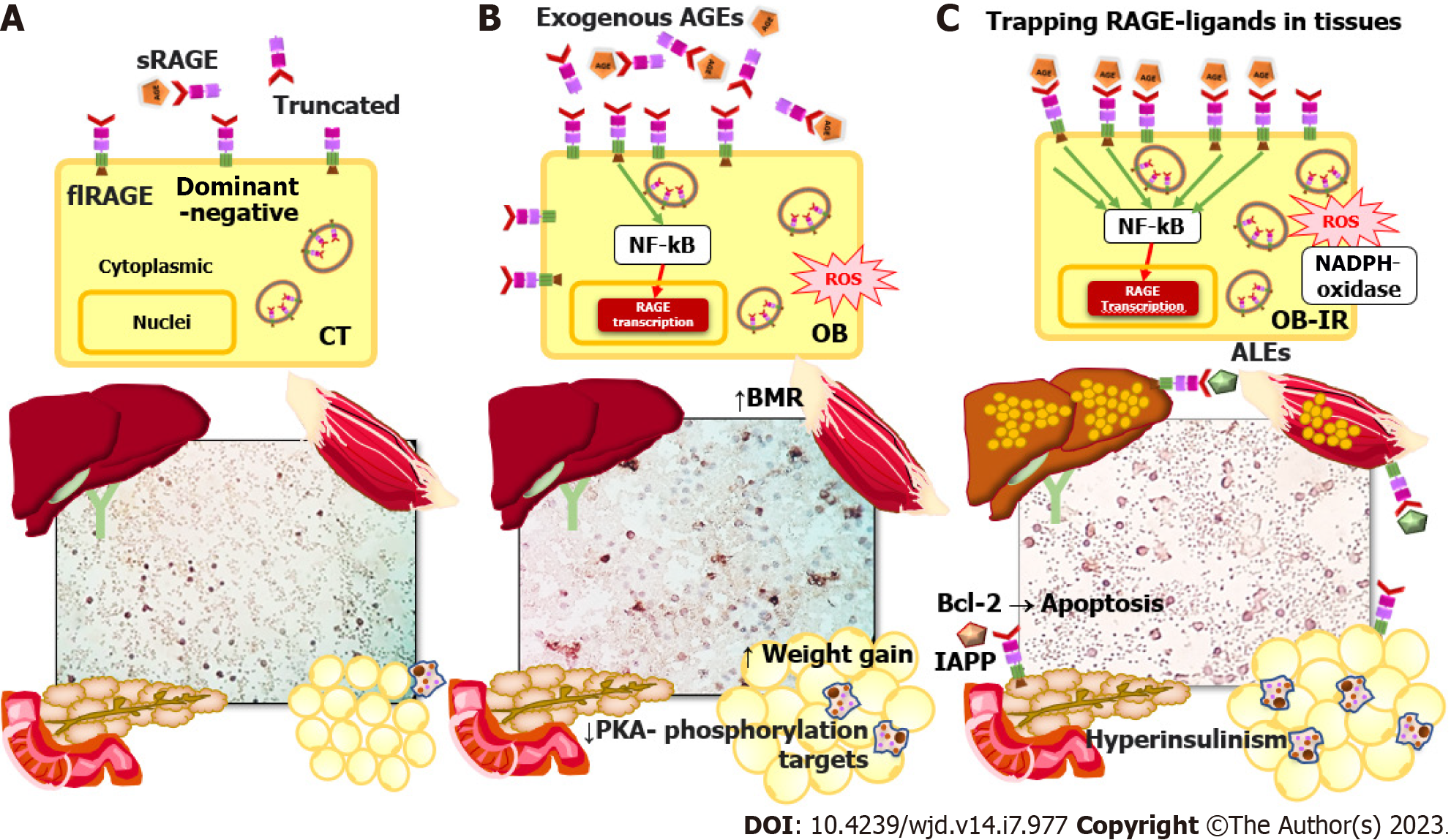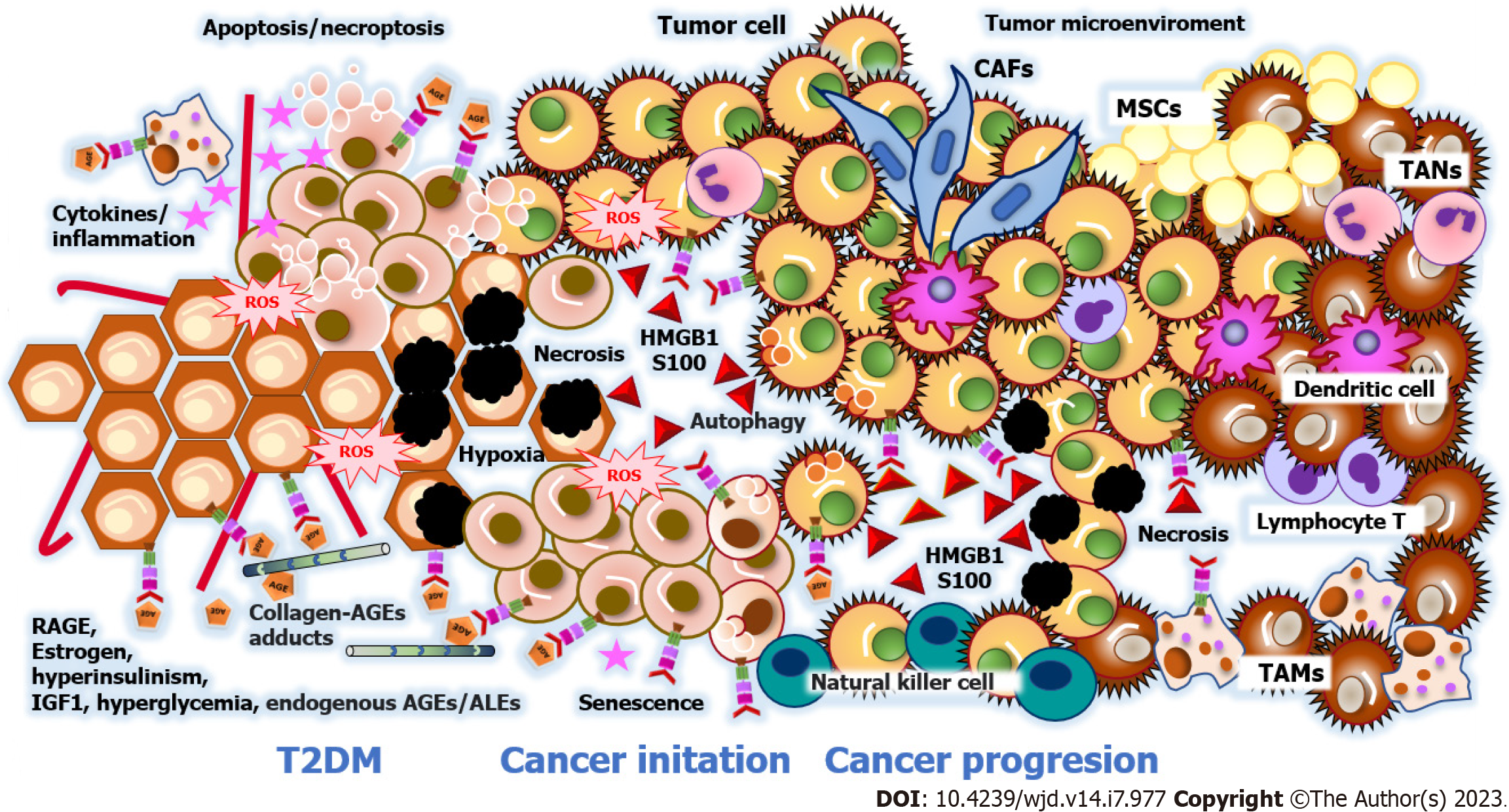Copyright
©The Author(s) 2023.
World J Diabetes. Jul 15, 2023; 14(7): 977-994
Published online Jul 15, 2023. doi: 10.4239/wjd.v14.i7.977
Published online Jul 15, 2023. doi: 10.4239/wjd.v14.i7.977
Figure 1 Receptor for advanced glycation products signaling and molecular mechanisms involved in progression from obesity to type 2 diabetes mellitus.
Receptor for advanced glycation products (RAGE)-ligand signaling in healthy control subjects, obese individuals (OB), and OB with insulin resistance is illustrated. A: Full-length, total soluble, dominant-negative (intracytoplasmic, lacking domain), and truncated (lacking a V-terminal) RAGE isoforms; B: Basal metabolic rate increase in muscle, decreased phosphorylation targets of protein kinase A, and weight gain (adipose tissue) are findings in obesity related to increased RAGE isoforms and ligands; C: The mechanism trapping RAGE-ligand in tissues involves translocation of cytoplasmic RAGE to the membrane, inflammation (nuclear factor-kappa B), and oxidative stress (NADPH-oxidase) in peripheral mononuclear blood cells, liver, muscle, pancreas, and adipose tissue. The B cell lymphoma-2 proto-oncogene mediates RAGE apoptosis signaling in pancreatic beta cells and leads to type 2 diabetes mellitus. Advanced glycosylation end products, advanced lipoperoxidation end products, and islet amyloid polypeptide (also known as amyloid) are RAGE ligands. RAGE: Receptor for advanced glycation products; CT: Control subjects; OB: Obese individuals; OB-IR: Obese individuals with insulin resistance; flRAGE: Full-length receptor for advanced glycation products; sRAGE: Soluble receptor for advanced glycation products; BMR: Basal metabolic rate; PKA: Protein kinase A; NF-kB: Nuclear factor-kappa B; PBMCs: Peripheral mononuclear blood cells; Bcl-2: B cell lymphoma-2; AGEs: Advanced glycosylation end products; ALEs: Advanced lipoperoxidation end products; IAPP: Islet amyloid polypeptide.
Figure 2 Tumor microenvironment in type 2 diabetes mellitus.
In type 2 diabetes mellitus patients, elevated estrogen levels, hyperinsulinemia, insulin-like growth factor-1 levels, hyperglycemia, endogenous advanced glycosylation end products (AGEs), and advanced lipoperoxidation end products (ALEs) promote cancer initiation and progression in the tumor microenvironment (TME). Receptor for advanced glycation products (RAGE) plays an essential role in the TME by promoting inflammation, oxidative stress, endotoxin clearance, senescence, and programmed cell death by binding to endogenous AGE/ALE ligands and damage-associated molecular patterns, primarily the high mobility group box 1 proteins and S100 proteins. To overcome a hypoxic and acidic microenvironment, tumor cells coordinate a metabolic program (Warburg effect), cell survival (senescence and cell death program), angiogenesis, extracellular matrix remodeling, proliferation, invasion, and metastasis. Tumor cells interact with resident immune cells and recruit mesenchymal stromal cells, cancer-associated fibroblasts, tumor-associated macrophages, tumor-associated neutrophils. RAGE: Receptor for advanced glycation products; ROS: Reactive oxygen species; T2DM: Type 2 diabetes mellitus patients; IGF-1: Insulin-like growth factor-1; AGEs: Advanced glycosylation end products; ALEs: Advanced lipoperoxidation end products; HMGB1: High mobility group box 1 proteins; MSCs: Mesenchymal stromal cells; CAFs: Cancer-associated fibroblasts; TAMs: Tumor-associated macrophages; TANs: Tumor-associated neutrophils.
- Citation: Garza-Campos A, Prieto-Correa JR, Domínguez-Rosales JA, Hernández-Nazará ZH. Implications of receptor for advanced glycation end products for progression from obesity to diabetes and from diabetes to cancer. World J Diabetes 2023; 14(7): 977-994
- URL: https://www.wjgnet.com/1948-9358/full/v14/i7/977.htm
- DOI: https://dx.doi.org/10.4239/wjd.v14.i7.977










